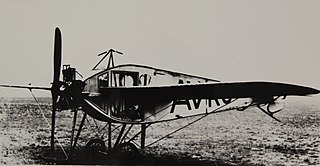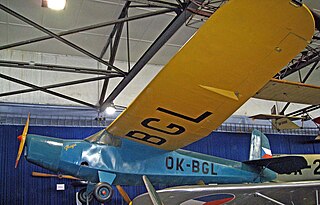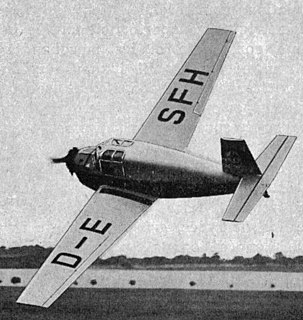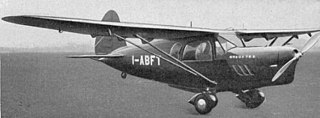Related Research Articles
The Arpin A-1 was a two-seat low-wing monoplane which was powered by a single radial engine in pusher configuration, mounted behind the cabin between twin booms that carried the tail. An unconventional fixed tricycle undercarriage was fitted. Only one was built.

The Avro Type F was an early single seat British aircraft from Avro. On 1 May 1912 it became the first aircraft in the world to fly with a completely enclosed cabin for the pilot as an integral part of the design.

The Praga E.114 was a single-engine sport airplane, designed and manufactured by the Czechoslovakian company ČKD-Praga. Due to its light weight it was also called Air Baby.
The IAR-821 was an agricultural aircraft built in Romania in the 1960s. It was a conventional low-wing monoplane with fixed, tailwheel undercarriage.

The Siebel Si.202 Hummel ("Bumble-bee") was a German light sportsplane of the late 1930s. It was an angular low-wing monoplane, which could be powered by a variety of small engines.
The Blackburn Second Monoplane was strongly influenced by the French Antoinette and was much more successful than Robert Blackburn's first aircraft. The lone aircraft was built in Leeds, UK in 1910.

The Fairey G.4/31 was a British single-engined, two-seat biplane contender for an Air Ministry specification for a multi-role or general purpose aircraft. Unsuccessful, only one was built.
The BFW M.26 was a single-engined cantilever-winged monoplane light airliner built in Germany in 1930. There were no sales and only one was built.

The Breda Ba.79S was a single-engine four-seat high-wing private aircraft built in Italy in the late 1930s. Only a few were produced.

The Civilian Coupé is a British, single-engined two-seat private monoplane built starting in 1929. Only five were made and it was the Civilian Aircraft Company's only product, but one still flies in the UK.

The Gwinn Aircar was a single-engined biplane with a cabin for two, designed in the US as a safe and simple private aircraft. Lacking a rudder, it had several unusual control features as well as an early tricycle undercarriage. Development was abandoned after a crash in 1938.

The Bernard SIMB AB 12 was a French single engine, single-seat monoplane fighter aircraft built in the 1920s. Though advanced for its time, it failed to gain a production order and only one was built.

The Timm T-840 was a twin engine, high wing passenger aircraft designed and flown in the United States in 1938. Equipped with a tricycle undercarriage and low speed aerodynamic devices, it could be configured to carry between six and ten passengers. Only one was built.
The Wendt W-2 Swift was a two-seat, single-engine, braced high-wing monoplane built in the United States just before World War II. Only one was built.
The Pander Multipro was a two/three seat light monoplane aircraft with a high, braced wing, designed in the Netherlands in the early 1930s. Powered by a Pobjoy radial engine, three were built.
The Gribovsky G-21 was a single engine cabin monoplane designed and built in the USSR in the mid-1930s. Intended for touring and civil utility rôles, only one was completed.
The Gribovsky G-27 was a light, economical, twin engined, multi-role aircraft built in the USSR in 1938-9. It did not reach production.

The Delanne 11 was a French two seat touring aircraft. Only one was built.

The Nieuport-Delage NiD 590 was a three engine, high wing monoplane designed for policing and other roles in France's colonies, which did not go into production or enter service.
The Simplex Red Arrow was a US single-engined monoplane produced in the late 1920s and early 1930s and intended as club machine or mail transport. Most used radial engines in the 90–110 hp (67–82 kW) range. They carried one or two passengers whose seats could be open or enclosed. One variant, the Red Arrow Dual Plane, was easily converted from monoplane to biplane and was available with two versions of the much more powerful Wright Whirlwind engines. In all about 20 were built.